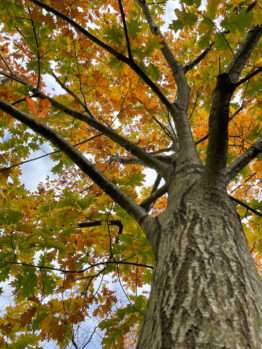Northern Red Oak
Researched by Ernest Nebedum
 Species: Quercus rubra
Species: Quercus rubra
Common name: Northern red oak
Family: Fagaceae (Oak Family)
Clade: Angiosperms (flowering seed plants)
Coordinates: 39.70658126, -75.11789037
A tag using this number is placed near the tree.
The Quercus rubra tree, commonly referred to as the northern red oak, is known for its dark reddish gray-brown bark with scaly, broad, thin, rounded ridges. The ridges have shiny stripes running down their center. This tree also exhibits distinct leaf characteristics. It grows in an alternating pattern on branches, and each leaf has seven to 11 lobes. The leaves change from green to yellow, orange, and red in the fall before dropping for winter. The geographic origin of this species is North America, and it grows within a temperate deciduous forest biome. The current natural distribution of the Quercus rubra includes the northeastern United States and southeastern Canada. The lifespan of this species is about 200 years, but it can live up to 400 years in rare cases. A mature Quercus rubra can grow up to 75 feet tall. Like all oak species, the northern red oak produces acorns as fruit that contain the seed as a means of reproduction. A notable interaction between oaks and animals is birds, squirrels, mice, and insects that consume fallen acorns. While many acorns become a meal, some are dispersed, buried, and forgotten by these woodland critters, enabling them to sprout. Read More
Campus Species Map
Researcher’s Biography
 Ernest Nebedum
Ernest Nebedum
Ernest Nebedum earned a Bachelor of Science degree in Biological Science in 2022.
Suggested Citation:
Nebedum, Ernest. (2021, Dec). Northern Red Oak. Rowan University Arboretum. https://arboretum.rowan.edu/trees/northern-red-oak/
Questions to Explore
- How did the Lenape people utilize the Northern red oak?
- How was the Northern red oak used medicinally?
- Describe recent medical research related to the Northern red oak.
- How did Native Americans likely use Red Oak trees for navigation? (Hint: explore the keywords: bent tree trail markers)
- How did oak trees influence the settlement and growth of Glassboro, New Jersey?
References
Arbor Day Foundation. (n.d.). Northern Red Oak Quercus Rubra. Arbor Day. | Link
Dunkle, P. (2017, February 18). The Sacred Oak Of Oley. International Oak Society. | Link
Licht, W., Lloyd, M. F., Duffin, J. M., McConaghy, M. D. (n.d.). The Original People And Their Land: The Lenape, Pre-History To The 18th Century. West Philadelphia Collaborative History. | Link
Southern Research Station. (n.d.). Quercus rubra L. | Link
Taib, M., Rezzak, Y., Bouyazza, L., & Lyoussi, B. (2020). Medicinal Uses, Phytochemistry, and Pharmacological Activities of Quercus Species. Evidence-based complementary and alternative medicine: eCAM, 2020, 1920683. | Link
The Morton Arboretum. (n.d.). Northern Red Oak. | Link
Three Rivers Park District. (n.d.). Species spotlight: Northern red oak trees. Three Rivers Parks. | Link
Yale University. (n.d.). Northern Red Oak. Yale Nature Walk. | Link
Rowan University Resources
You may need to log into the Rowan University Library website.
Trees in our Pocket: a guide to Trees of the Upper Midwest | Link
Effects of acorn size and mass on seeding quality of northern red oak | Link
Trailside Botany: 101 Favorite Trees, Shrubs, and Wildflowers of the Upper Midwest | Link



















